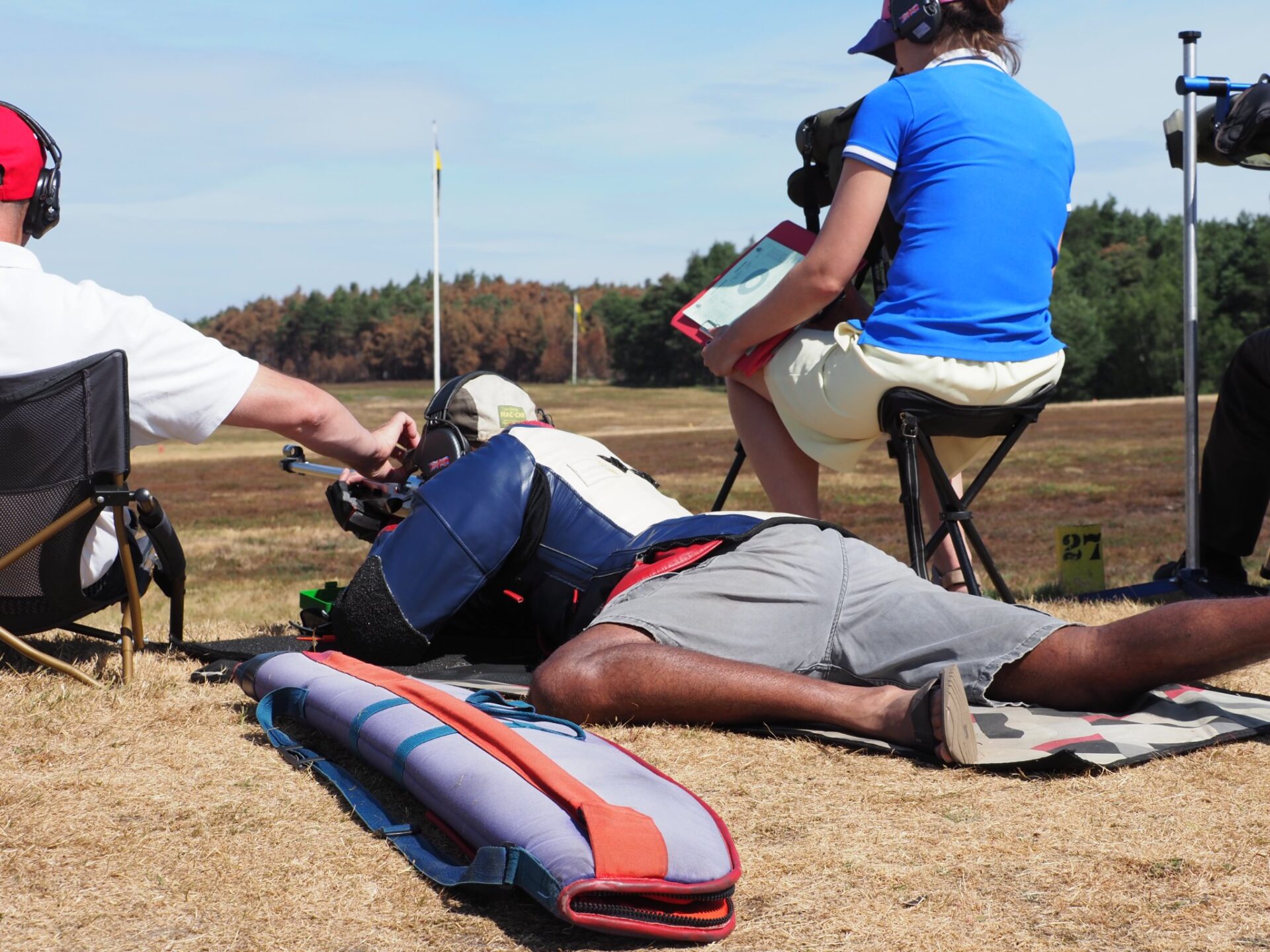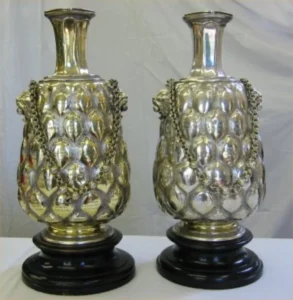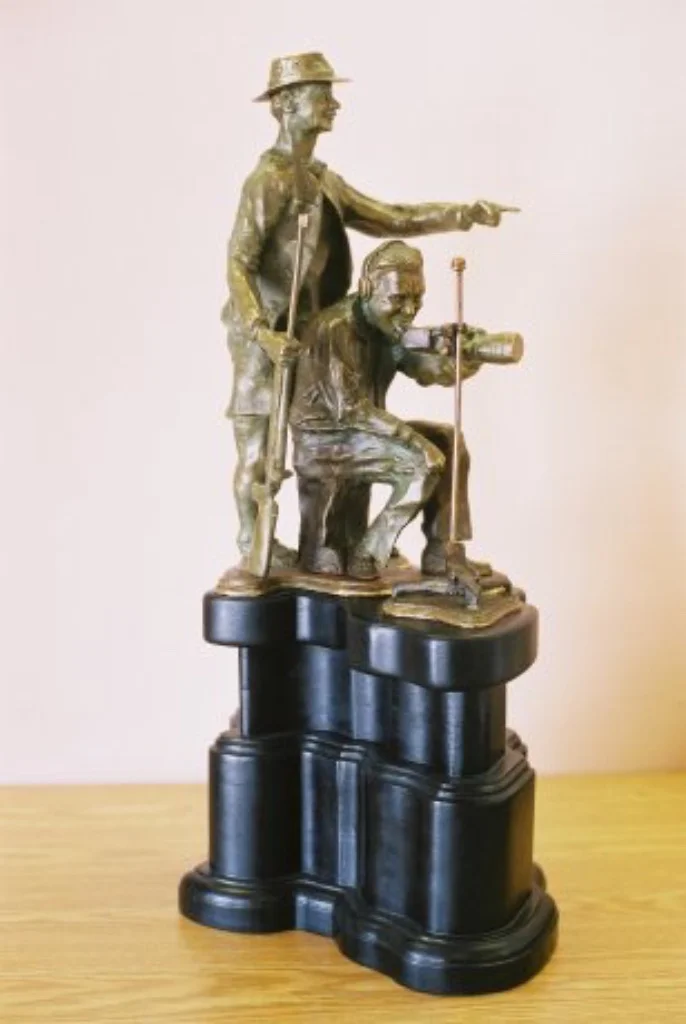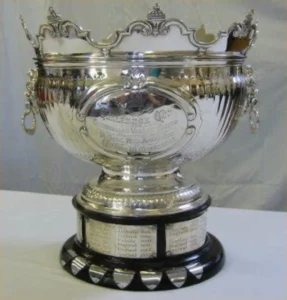International Team Matches
Team Competitions

In team matches, shooters will generally shoot in strings with another member of the team judging the wind and moving the firer’s sights. As you can see in the photo to the right, the coach normally sits next to the firer to give him a better view of the range. Adjacent to the coach, another team member ‘plots’ the shots on a score diagram. This allows the firer to concentrate on just firing good shots and the coach to watch the wind.
Often, in bigger matches, where the team has more than one target, there will also be a main coach whose job it is to provide a link between all the targets and give a standard wind call.

The wire badges that are presented to individuals representing a team in the ‘Big 5’ Matches. (The white cross in the center, is the badge presented to an England team member in for the National Match. The Mackinnon badge here is also the English one.)
Details on each of these matches can be found by clicking on the relevant link.
The Trophy
The original trophy, (a replica of a Roman SPQR standard) stood at 7 foot 6 inches high, and was made of steel inlaid with gold and silver and enriched with elaborate mountings of copper. The word Palma (Latin for victory or valour) replaced the letters SPQR on the standard, and so the competition became known as the Palma Match.
This original trophy was last seen in the Pentagon in Washington DC, prior to the Second World War. A replacement trophy was presented in April 1988 by an American benefactor, Herbert Macgregor Aiken (this trophy is still large but about half the original size).

Match Background
The first recorded International Long Range Rifle match was fired on Creedmoor Range in the USA in 1873 between teams from Ireland and the USA, resulting in a win (by three points only) for the USA. The match conditions were 15 shots at each of 800 yards and 900 yards, and 20 shots at 1000 yards. A return match was held in 1874 at Dollymount Range in Ireland and again the USA won, this time by a margin of 39 points. The American team then travelled to Wimbledon, the original home of the NRA, to enter the Elcho Shield match for long range shooting, but were not allowed to enter since the match conditions at the time only allowed teams from England and Scotland.
The two matches in the USA and Ireland, and the visit of the Americans to Wimbledon, caused the (then) Board of Directors of the NRA of America in 1875 to consider putting International competition onto a “regular” footing. The records of this meeting record that “The prize will be a handsome Trophy presented by the citizens of the United States”. The match conditions were to be 30 shots at each of 800 yards, 900 yards and 1000 yards, but were to be for teams of 8 firers.
The Palma Trophy Match was first fired in 1876 between teams from Scotland, Ireland, Canada, Australia and the USA, and was followed by a return match in 1877. For some unknown reason no teams answered the challenge in 1878, and the match lapsed until it was revived in 1901 with two teams only, from the USA and Canada, competing. The match was held a total of six times in the period leading up to the Great War, when it again lapsed. The match was held again in 1928 against a Cuban team only, and then again lapsed until 1966.
The Palma match is considered the pinnacle of fullbore team shooting around the world and is more commonly known as The World Championship for Long Range Rifle Shooting.
Match Conditions
The Palma Match is shot over 2 days, each team consisting of 16 firers and 4 coaches with a main coach. The course of fire is 2 sighters and 15 shots to count at 800, 900 and 1000 yards (or 700, 800 and 900 metres) on each of the 2 days.
2011 saw the adoption of new a new scoring system with each bulls-eye scoring 5 points, not 10 as in previous years. The highest possible score is 7200 with 1440 v-bulls per team (450 with 90 v-bulls per person).
In 2015 Great Britain broke their own record from 2011 to score 7106 with 825 v-bulls. The highest individual score is 449 with 55 v-bulls, set by Toby Raincock of Great Britain in 2015.
In 2015 the first Arthur Clarke Memorial Medal was awarded to the highest-scoring target coach in the match. The current highest target team score was achieved by Matthew Ensor (coach and recipient of the medal), Parag Patel, James Watson, Toby Raincock and Jon Underwood of Great Britain with a score of 1783 and 211 v-bulls (out of a maximum 1800 and 360 v-bulls).
Previous Winners
| 1876 | USA | 1968 | Canada | 1988 | Australia |
| 1877 | USA | 1969 | USA | 1992 | Great Britain |
| 1901 | Canada | 1970 | Great Britain | 1995 | Great Britain |
| 1902 | Great Britain | 1971 | USA | 1999 | South Africa |
| 1907 | USA | 1972 | Canada | 2003 | Great Britain |
| 1912 | USA | 1973 | USA | 2007 | Great Britain |
| 1913 | USA | 1974 | South Africa | 2011 | Great Britain |
| 1924 | Canada | 1976 | USA | 2015 | Great Britain |
| 1925 | USA | 1979 | Australia | 2019 | Australia |
| 1966 | USA | 1982 | Canada | ||
| 1967 | Canada | 1985 | USA |
The Trophy
In 1870 the Rajah of Kolapore presented £100 to the NRA as a prize. He had also sent his £10 subscription, but died suddenly some months before the Wimbledon meeting of 1871. The NRA Council decided that the whole amount should be invested in a trophy, a pair of silver challenge vases, to be called after the Rajah and to be competed for by teams from India, the Colonies and one United Team from the Mother Country (since renamed to Great Britain).

Match Background
The first match was held in 1872 between teams of 20 from Canada and Great Britain. Canada won the first match. In 1872 the number of firers in each team was reduced from 20 to 8.
India have competed since 1874. In 1876 the Great Britain team had to be selected from those who had taken part in the National Match and had to include the 2 lowest scorers. Jersey and Guernsey entered for the first time in 1882. The Australian states of Victoria and Queensland entered in 1897 as well as New Zealand and Natal of South Africa. Australia entered as a country for the first time in 1902 and won the match. West Indies entered in 1908 as West India. South Africa entered as a country for the first time in 1910.
From 2015 onwards the match has been shot using more difficult ICFRA targets. When shot using the UK NRA target dimensions the match record was held by Great Britain with a score of 1199 with 201 v-bulls, out of 1200 with 240 v-bulls. This was achieved by Nick Tremlett’s team in 2012. The highest individual score using those targets was 150 with 29 v-bulls by Paul Kent (Great Britain) in the same year.
The record with the new target dimensions is 1196 with 151 v-bulls, achieved by Great Britain in 2016. The new highest individual score in the match is 150 with 24 v-bulls by Jon Underwood (Great Britain) in the same year.
Match Conditions
Up to 1908 the match conditions were 7 shots at 200, 500 and 600 yards. From 1908 to 1914, it changed to 7 shots at 300, 500 and 600 yards. In 1919 the number of shots increased to 1 sighter and 10 shots at 300, 500 and 600 yards and this has remained in place to this day. The match is shot at Bisley during the annual Imperial meeting.
Previous Winners (1871-2023)
| Great Britain | 100 | South Africa | 3 | India | 1 |
| Canada | 22 | Jersey | 2 | Rhodesia | 1 |
| Australia | 9 | New Zealand | 2 | Victoria | 1 |
The Trophy
The trophy was presented in 2002 on the occasion of the first match. It was made possible by the fund-raising effort of Precision Shooting Magazine. The two figures depicted in the sculpture are the Canadian Jim Thompson, and Alan Warner (standing) of the United States. George Chase a member of the DCRA from New Brunswick was commissioned to design and make the trophy.
Match Background
First shot in 2002, the match can only take place when an official US team is present and competing. The intent is to hold the match every two years, with the last one held during the 2012 USA National Matches at Camp Perry range in Ohio, USA.
In 2002, USA, Canada, Great Britain and Germany competed for the match. On this occasion, Great Britain won the match from Canada with a margin of 48 points with USA a further 9 points behind them. In 2013 the America Match was held in South Africa and in 2019 in the UK, thus joining the Australia and Palma Matches as an exclusive group to be hosted at different locations around the world.

Match Conditions
A team of 8 shooters, two target coaches, a main coach, an adjutant, a captain and two reserves.
Each firer shoots 2 sighters and 15 shots to count at 300, 600, 900 and 1000 yards (or 300, 600, 800 and 900 metres as appropriate to the venue).
The record score is 2392 with 339 v-bulls by USA in 2014 and the highest individual score is 300 with 46 v-bulls by Des Vamplew (Canada) in 2010.
Previous Winners
| 2002 (held in Canada) | Great Britain |
| 2004 (held in USA) | Unites States of America |
| 2006 (held in Canada) | Great Britain |
| 2008 (held in USA) | United States of America |
| 2010 (held in Canada) | Great Britain |
| 2012 (held in USA) | United States of America |
| 2013 (held in South Africa) | South Africa |
| 2014 (held in Canada) | United States of America |
| 2015 (held in USA) | Great Britain |
| 2018 (held in Canada) | United States of America |
| 2019 (held in UK) | England |
| 2022 (held in Canada) | United States of America |
The History
Great Britain received a cordial invitation in 1906 from the Rifle Association of Australia, to send a Team in 1907 to compete in an “Imperial Match”.
On learning of the intended tour, the Dominion of Canada Rifle Association gave a very pressing invitation to arrange for the team to visit Canada en route, and take part in the match for the Palma Trophy in Ottawa.
The seventeen men of the Great Britain Rifle Team to Canada and Australia, 1907, were led by Major P.W. Richardson and sailed from Liverpool on 9th August.
Having shot in the Palma match, they sailed onto Sydney, Australia and shot for three days in Queensland. The first Imperial Match was shot over the two following days later, it was renamed the Empire Match. In 1988 it was once again renamed to the Australia Match.
A splendid silver trophy was presented for the competition. Mounted on black marble, it weighs over 100kg. (Perhaps one of the reasons it does not leave Australia when other nations win the competition).
From 2010 the match has been shot on ICFRA targets. The Great Britain team won the match that year, scoring 1972 with 207 v-bulls (out of a possible 2000 with 400 v-bulls), thereby setting a new record score. Tom Rylands (Great Britain, 2010) and Bryan Litz (USA, 2011) hold the highest individual score of 200 with 26 v-bulls. The previous team record was held by Australia, scoring 1977 with 217 v-bulls at Brisbane in 2005.

Match Conditions
The Australia Match is shot for by a team of 10 shooters, 2 target coaches, a main coach, Captain and Adjutant. 2 reserves may also be selected.
Each shooter fires 2 sighters and 10 shots to count at 300, 600, 900 and 1000 yards.
Previous Winners
| Great Britain | 24 wins |
| Australia | 18 wins |
| New Zealand | 6 wins |
| Canada | 4 wins |
The History
The Protea Match is the most prestigious international team match hosted each year in South Africa. GB Teams have competed in various international ‘test matches’ in South Africa from the first overseas tour to visit in 1921 but the first time a GB team competed in the Protea Match, as it is now named, was in 1998.
Each international team consists of twelve shooters, three coaches, a main coach, an adjutant, a captain and three reserves. The normal course of fire is for each shooter is 10 shots to count at each of 300, 600 and 900 metres.
A spectacular new trophy (pictured) was first awarded to the winners of the Protea Match from 2017 onwards. In that year, Great Britain broke the previous match record with a score of 1780 and 213 V Bulls.

Match Conditions
In 2024, the match conditions are changed from 12 firers across 3 targets (to be shot at 300, 600 and 900m) to 16 firers across 4 targets, who each fire 10 counting shots at 300m, 600m, 800m and 900m.
The highest possible score for each team is normally 1800 and 360 v bulls. In 2024 it is 3200 and 640 V Bulls.
Previous Winners (to 2023 with GB team present)
| South Africa | 10 wins |
| Great Britain | 4 wins |
| Australia | 1 wins |
The Trophy
The Canada Match is a Challenge Cup presented by The Canadian National Railways 1931, for competition between teams representing the Mother Country and Canada at the Annual Prize Meeting of The Dominion of Canada Rifle Association.
The trophy is a Sheffield Sterling Plate Bowl style cup with two handles, a lid on which stands a Victory Figure, a long stem tapering to a tiered and flared base. With the lid in place the trophy stands 657 mm high, 430 mm across the handles, 280 mm in diameter at the top, 178 mm in diameter at the flared base. The Trophy stands on a wooden base which is mahogany in colour and which measures 134 mm high and 330 mm square.

The History
In 1931 Great Britain sent a rifle team to Canada under command of Sir Lionel Fletcher, CBE to compete against Canada’s best marksmen at the Annual Prize Meeting of the DCRA. Prior to that year no International team matches were included in the regular schedule of events. It was considered fitting therefore that a short range event following the Traditional Conditions prescribed for “The Kolapore” at Bisley be introduced. The conditions called for teams of 8 marksmen each firing two sighting shots and ten shots for record at each of 300, 500 and 600 yards within a specified time limit. The match was titled “The Canada Match” and with the assistance and generosity of The Canadian National Railways, the Canada Trophy was placed in competition.
Match Conditions
The Canada Match is always shot in Canada, by a team of 8 firers. Each shooter fires 2 sighters and 10 shots to count at 300, 500 and 600 yards. In 2012 Great Britain scored 1200 with 156 v-bulls out of 1200 with 240 v-bulls, breaking the previous record of 1199 set in 2007. This is the first time any team has achieved a maximum score in an international team match. The highest individual score is 150 with 28 v-bulls by David Luckman (Great Britain) in 2007.
Previous Winners (to 2022)
| Great Britain | 30 |
| Canada | 23 |
| Australia | 2 |
| England | 2 |
| USA | 1 |
The Trophy
The Commonwealth Trophy was presented to the Dominion of Canada Rifle Association by The Canadian Pacific Railway Company for annual competition between Empire Teams in 1931.
It is a Sheffield Sterling Bowl with two handles and a prone figure of a marksman mounted on the stem base. The bowl is mounted on a three tier black wooden base upon which the names of winning teams are recorded on small silver shields. Hallmarked M & W, the crown, Lion Passant and year of manufacture symbol. The bowl is 215 mm in height, 420 mm across the handles, 286 mm in diameter at the top and 193 mm in diameter at the base of the stem; the three tier wooden base is not shown in the photo.

The History
In 1931 Great Britain sent a rifle team to Canada under command of Sir Lionel Fletcher, CBE, to compete against Canada’s best marksmen at the Annual Prize Meeting of the DCRA. Prior to that year, no international team matches were included in the regular schedule of events. It was considered fitting that a long range event following the traditional conditions of “The Mackinnon” at Bisley be introduced. The conditions called for Teams of 12 marksmen each firing 2 sighting shots and 10 shots for record at each of 900 and 1000 yards within a specified time limit. The match was Titled “The Empire Match” and with the assistance and generosity of The Canadian Pacific Railways Company, the Empire Trophy was placed in competition.
While the general conditions of “The Empire Match” have continued through the years, it was renamed “The Commonwealth Match” following World War II and is currently fired at 800 and 900 meters.
Match Conditions
The Commonwealth Match is always shot in Canada, by a team of 12 firers. Each shooter fires 2 sighters and 10 shots to count at 800m and 900m. The highest individual score is 100 with 18 v-bulls by Jim Paton (Canada) in 2013. Lindsay Peden’s Great Britain team from 2016 holds the record score of 1194 and 138 v-bulls.
Previous Winners (to 2022)
| Great Britain | 32 |
| Canada | 19 |
| Australia | 4 |
| New Zealand | 2 |
| England | 1 |
The Trophy
The Mackinnon was first shot in 1891 for a purse of £20 donated by Colonel W. Mackinnon, Secretary of the NRA. The following year Colonel Mackinnon presented the current trophy.

The History
First shot in 1891, the match was originally open to teams of “Efficient Volunteers” from England, Scotland, Ireland, Wales, India, Canada and several colonies, firing five directed volleys at 400 yards.
In 1902 the match conditions were changed to teams of 12, shooting 10 shots each at 900 and 1000 yards. These are the same conditions used today.
The highest possible score is 1200 with 240 v-bulls. The record score is 1188 with 149 v-bulls, achieved by England in 2014. The highest individual score is 100 with 19 v-bulls, scored by Glyn Barnett (England) in 2019.
Previous Winners (1891-2023)
| England | 73 | Australia | 8 | New Zealand | 2 |
| Scotland | 19 | South Africa | 3 | Southern Rhodesia | 1 |
| Canada | 15 | Ireland | 2 |
The History
In 1864, a “Rifle Conference” was held in London under much publicity. One of the outcomes of the conference was the establishment of what was originally known as the International Enfield Match for teams of English and Scottish volunteers. The first match was shot at Wimbledon in July 1864. After this occasion, invitations to design a trophy resulted in 22 entries. The winning design (shown opposite) was submitted by Messrs Elkington & Co. designed by their artist Mr Auguste Wilms.
The following year, 1865, an Irish team was admitted to compete and they have done so on almost all occasions since. From 1877 to 1879, Scotland abstained from competing in protest to the match being held at Wimbledon. In 1879, new rules were introduced that the match would be shot at Wimbledon except when won at Wimbledon when the captain of the team would be entitled to hold the match in their country. At this time, the Welsh were invited to join the competition and they first shot in 1881.
England have won the majority of matches including 36 consecutive victories between 1966 and 2001. In recent years the match has been more competitive with Ireland’s first win in 2002 and a Scottish double in 2010 and 2011. Wales broke their record at every distance in the match to emerge victorious for the first time in 2016 with a score of 2084 and 298 v-bulls.
The record score for the match is held by Nick Hinchliffe’s England team who scored 2087 with 278 v-bulls (out of 2100 with 420 v-bulls) in 2014. The highest individual score is a perfect 105 with 21 v-bulls by David Luckman (England) in 2010.

Match Conditions
The National match is shot for by a team from England, Ireland, Scotland and Wales each with 20 firers on 5 targets. Each shooter fires 1 sighter and 7 shots to count at 300, 500 and 600 yards. As mentioned above, the match is now held at Bisley but a winning team captain is entitled to hold the match in their own country as Ireland did in 2003.
Previous Winners (1864-2023)
| England | 112 |
| Scotland | 43 |
| Wales | 2 |
| Ireland | 1 |
